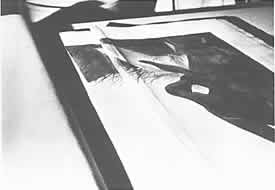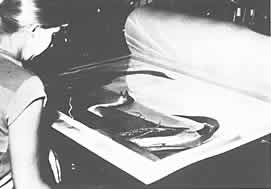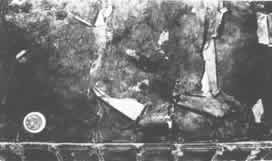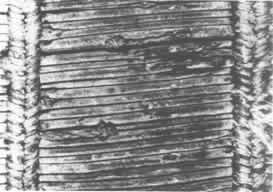Book Conservation and the Code of Ethics
by Don EtheringtonAs you most likely know, the Code of Ethics and the Standards of Practice of A.I.C. were developed in the 1960s as an outgrowth of the Murray Pease Report. They were formulated originally by art conservators. There have been revisions, and our current version dates from 1979.
There are many times when the book conservator and the library conservator in particular have trouble operating in an ethical framework based on the individual treatment of valuable paintings. As time is limited, however, I will focus on two representative areas and show a few examples.
The very first sentence after the preamble in the Code of Ethics (Part One, II.A.) requires that all actions of the conservator be governed by "unswerving respect for the esthetic, historic and physical integrity of the object." Well, a book conservator may respect the physical integrity of a book but he is as likely as not to destroy it. By that I mean he may break down a book's structure, reassemble the pieces, treat some of them, leave some alone, replace others, reassemble the book, and put it in a box with the remnants in a portfolio underneath.
Obviously there may be good reasons for this and I will talk about some examples in a moment. But. the point I want to make is that the daily conflict between the abstract idea of "respecting the integrity of the object" and the demands of treatments undermines the moral authority of the whole Code. It is easy to start thinking that the Code represents an unrealistic ideal, which cannot be achieved in practice. But yet we demand that conservators meet that ideal when they submit treatment documentation forms with their Professional Associate applications or when they apply for certification.
I think we all support the intent of this opening statement of the Code, which is that the object must be protected from arbitrary decisions by the conservator as well as by the owner or custodian. Perhaps the language can be changed to embody this concept without excluding the legitimate work of the book conservator.
The second area of the Code I would like to focus on is the insistence on a single standard. (Part One, II.C.) I quote: "regardless of his opinion of its value or quality, the conservator should adhere to each piece the highest and most exacting standard of treatment. Although circumstances may limit the extent of treatment, the quality of the treatment should never be governed by the quality or value of the object." Certainly a conservator should never knowingly employ a poor quality material which will cause harm to a treated object. Nor should he treat an item badly simply because it does not appeal to him.
But in institutions all over the country, decisions are made by respectable conservators after sober deliberation with curators and librarians about what objects to treat first, what objects to expose to the dangers of travel, and what materials to use in treatments and in housings. All these decisions affect the preservation of the items and are based largely on the importance of the items to the collection, their relative scholarly and aesthetic significance, their monetary worth and their nearness to the hearts of public and patrons. In other words, on considered opinions of their value and quality.
This is not wrong. It is a responsible allocation of resources. Time is the most important of those resources and not just in the negative sense. If I decide against pulling, washing, and alkalinizing a modern paperback and against sewing it into a conservation non-adhesive binding, it is not just because I do not have time to treat the whole library that way. If I had all the time in the world, I still would not do it.
The following examples illustrate different options that have been taken.
The Audubon elephant folios in nearly every extant set show similar damage caused by the size and quality of the paper, and weight of each bound volume. The paper is also bound the wrong way of the grain and does not flow well, so when the book is closed the weight of the cover causes the leaves to be creased. Figure 1. A decision was made to disbind and place the individual plates into folders.
Figure 2. The opposite option was selected for this thirteenth century Itinera in vellum detailing court proceedings in Hampshire, England which was left largely untouched and just boxed because of its historical importance relative to its structure. Figure 3. It shows, for example, tacketing stitches left intact that give evidence perhaps that the writing was done with the vellum gatherings put together before writing.
Book conservators also have difficulty in applying the single standard concept for documentation (Part Two, IV.C.2.). These examples illustrate how documentation was done on a sliding scale from minimum to extensive.
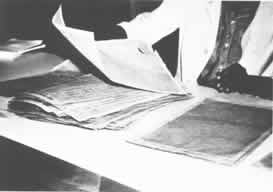
| 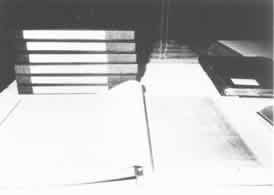
|
| Fig. 5. Disbound leaves of The National Intelligencer | Fig. 6. Leaves of The National Intelligencer reassembled in post-bindings. |
The National Intelligencer newspaper collection of 120 volumes, each with eighty leaves, was treated and rebound with minimum documentation though it was relative to the whole collection. Figures 5 and 6. Basically this is to say that there were many, many leaves, all exactly the same and minimum documentation was a correct course of action for this particular collection.
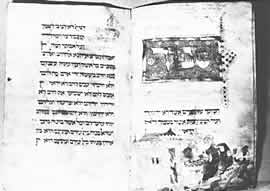
| 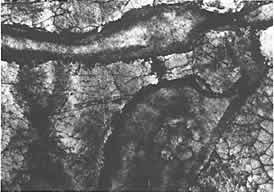
|
| Fig. 7. An opening of the Washington Haggadah | Fig. 8. Detail of a Washington Haggadah headpiece showing surface fissures in gilded letters. |
On the other hand, very extensive documentation was carried out on the Washington Haggadah. Every leaf of the manuscript was photographed and then selected areas of illumination and gilding on each page were recorded by macrophotography before any treatment options were considered. Figures 7 and 8. One reason this was done so extensively was to learn if proposed flattening of the vellum manuscript leaves would cause any change or damage to the gilding or the support layers underneath.
I think we need to establish in the Code some variables, not to change its concept, but just to show there are various levels of treatment and documentation requirements in our profession and we need to respect that situation.
